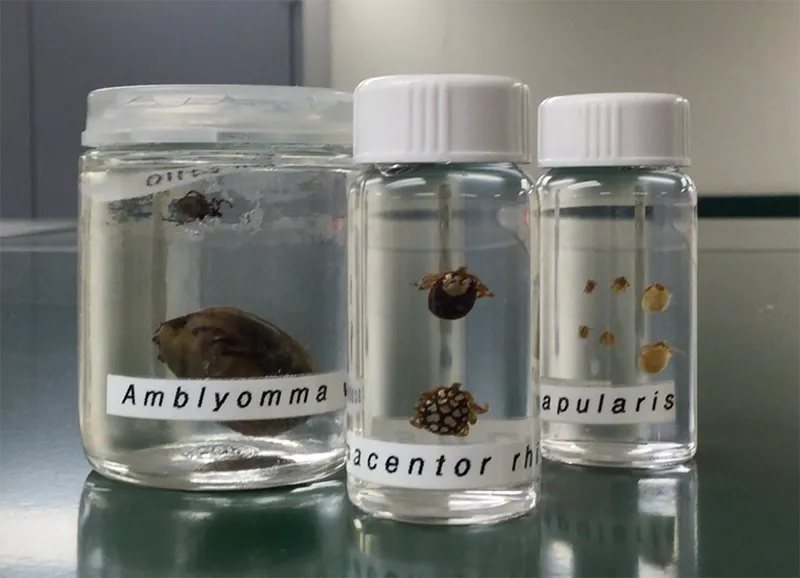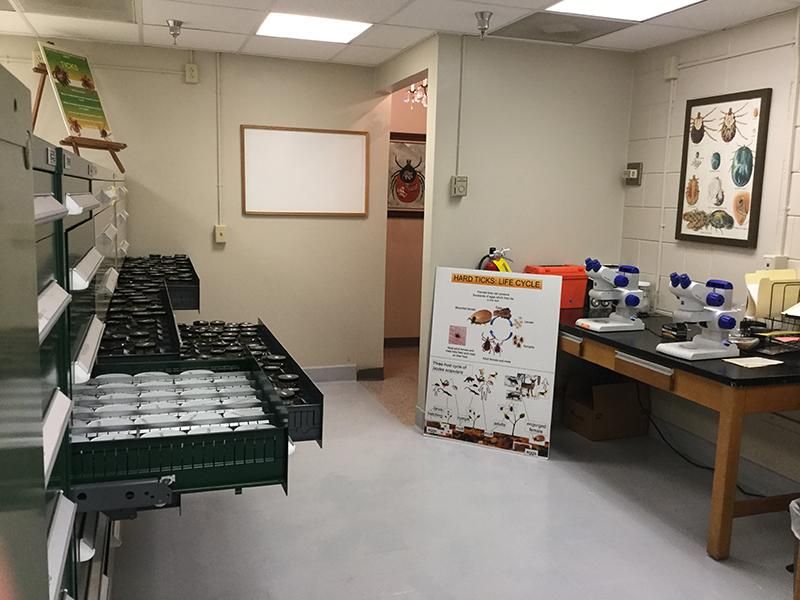More Than One Million Ticks Make Up This Cringe-Worthy Collection in Georgia
The U.S. National Tick Collection is the largest continuously curated collection of ticks in the world
/https://tf-cmsv2-smithsonianmag-media.s3.amazonaws.com/filer/87/cf/87cf3053-538e-4991-9a05-51e737cf5243/tick.jpg)
For most people, being surrounded by ticks is the stuff of nightmares, but at the U.S. National Tick Collection, an influx of arachnids is the norm. The collection, which is housed on the Georgia Southern University campus in Statesboro, Georgia, is considered to be the largest continuously curated collection of ticks in the world. The collection’s count hovers at more than one million specimens and continues to grow.
Since 1990 the collection, which belongs to the Smithsonian's National Museum of Natural History, has been on long-term loan with the university due to its strong focus on the study of entomology. Thanks to its location on campus, it’s readily available to students, researchers and the public to view and study (the assemblage of creepy crawlies is particularly popular among local elementary school groups). The collection’s comprehensive array of specimens contains ticks representing all seven continents (yes, this includes Antarctica, where ticks have been found feasting on the blood of seabirds) and nearly all of the approximately 860 known species of ticks found around the world. And there’s one person in particular who has an encyclopedic knowledge of every aspect of the collection: Lorenza Beati.
For the past 13 years, Beati has served as the collection’s curator. (She’s also a professor of biology at the university and has spent much of her career studying the taxonomy of ticks and how they transmit diseases to humans and animals.) In her role, she’s tasked with maintaining the collection, which is meticulously arranged inside metal cabinets located inside the university’s Math and Physics Building. Upon first glance, the collection doesn’t look like much, but inside each of the cabinet’s drawers resides dozens of bottles, each one filled with ethanol to help preserve the delicate specimens, which are suspended in the clear alcohol. Each bottle has a barcode on it to keep track of pertinent information about that specimen, such as when and where it was found, what kind of species it is, and any diseases connected to it. In addition to the individual ticks, the collection also contains 125,000 accessioned lots comprised of multiple ticks discovered together during offsite fieldwork, plus an extensive library of books and monographs related to the subject of ticks.

“The collection is over 100 years old,” Beati says. “What makes it unique from other tick collections is that it has been continuously curated for all these years and never wound up forgotten in a basement somewhere collecting dust.”
Before landing at its current temporary home at the university, the collection changed hands multiple times, with its beginnings dating back to the early 20th century when pathologist Howard T. Ricketts discovered that a certain species of ticks (Rickettsia rickettsia) was responsible for transmitting pathogens to humans, in this case Rocky Mountain spotted fever. From there, it moved to the Department of Entomology and Zoology of Montana State College (now Montana State University) while Ricketts was doing research in the state before being transferred in 1931 to Rocky Mountain Laboratories, part of the National Institutes of Health (NIH). It stayed there until 1983 when Rocky Mountain Laboratories donated it to the National Museum of Natural History, which is currently loaning it to Georgia Southern University.
Thanks to ongoing acquisitions and active fieldwork, Beati and her team are continually adding new specimens to the collection, which represents approximately 96 percent of ticks species found around the world. However, there are some species that may never get added.

“In some parts of Asia we’re unable to get [specimens] out of the country [due to regulations]—for example China,” she says. “Eighty years ago people would collect what they wanted and bring specimens home with them, but that’s no longer the case.”
And the variety of specimens is just one hallmark of the collection, which includes everything from the common American dog tick (Dermacentor variabilis) to the winter tick (Dermacentor albipictus). It also contains ticks that have some sort of historical significance.
“We have a tick that was found on President Teddy Roosevelt’s dog,” she says.
Over the years, the collection has also remained an important resource for researchers to learn more about the transmission of different diseases from ticks to humans and animals. Recently, one tick in particular has been garnering headlines. Known as the Asian longhorned tick (Haemaphysalis longicornis), this invasive species has been found in nine states across the eastern United States since reaching the Western Hemisphere in 2017. According to the Centers for Disease Control and Prevention (CDC), there have been cases, outside of the United States, where bites have made people and animals very sick.
“Research has found that the saliva of this species of ticks can cause a reaction in humans and cause them to develop a meat allergy,” says Floyd W. Shockley, the collections manager of the National Museum of Natural History’s Department of Entomology. “We’re not quite sure how it made it to the United States, but we think it must have hitched a ride on livestock, such as cattle or sheep.”
Continuing research on the Asian long-horned tick and utilizing the resources provided by the U.S. National Tick Collection brings scientists one step closer to understanding this species and what threats it might have on humans in the future.
“By studying tick saliva and how it promotes the growth of viruses,” says Shockley, “we can have a better understanding of viral transmissions of other diseases—even ones not necessarily transmitted by ticks—and how viruses spread across the board.”
Tours of the U.S. National Tick Collection are available by appointment. To schedule a tour contact [email protected].